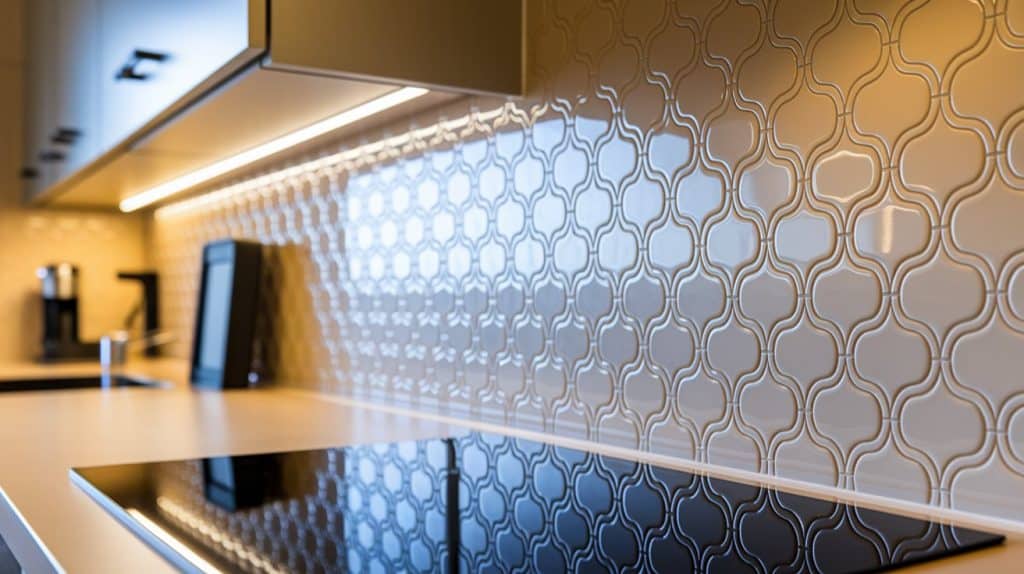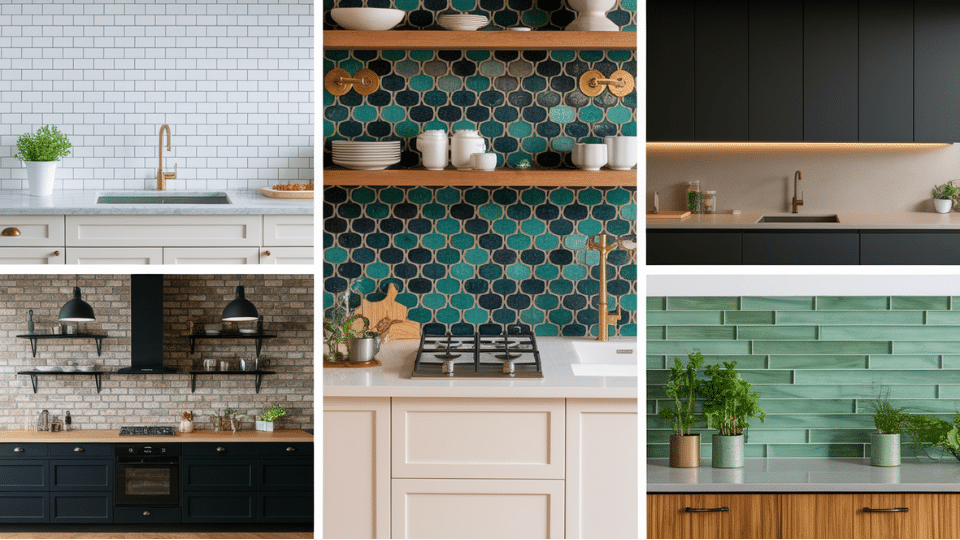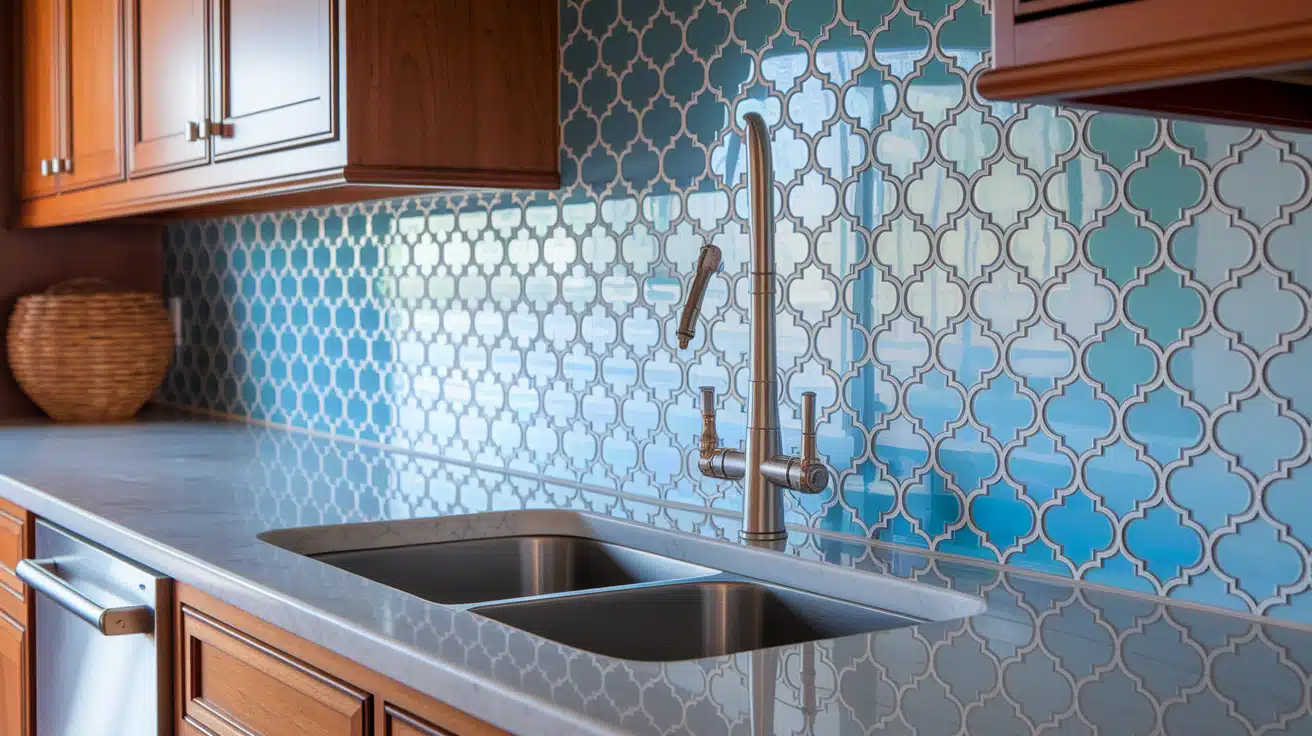Your kitchen and bathroom walls are constantly exposed to water, grease, and daily splashes. Without proper protection, these surfaces can suffer permanent damage, which can cost thousands to repair.
A backsplash solves this problem while adding style to your space.
Installing the right backsplash protects your walls from moisture damage and stains. It makes cleaning easier and can boost your home’s resale value.
From budget-friendly ceramic tiles to luxurious natural stone, there’s a backsplash material for every style and budget.
This guide covers everything you need to know about backsplashes. You’ll learn what they are, where to use them, and which materials work best for your needs.
By the end, you’ll understand how to choose the perfect backsplash for your home.
What is a Backsplash?
A backsplash is a vertical surface made of tile, stone, glass, or other materials that protects your walls from water damage, grease stains, and everyday splashes.
Originally introduced in the 1920s as kitchens became more modern, backsplashes gained popularity in the 1950s when homeowners began focusing on both function and style.
Today, you’ll find backsplashes in kitchens behind sinks and stoves, bathrooms around vanities and tubs, laundry areas near washing machines, and wet bars for easy cleanup.
Standard backsplashes typically measure 4 inches high, although many homeowners now choose heights of 18-20 inches or even full-wall coverage for maximum protection and visual impact.
Types of Backsplash Materials
- Ceramic & Porcelain Tiles: The most popular choice for homeowners wanting durability, style variety, and wallet-friendly prices that work in any space.
- Glass Tiles: Ideal for small kitchens and bathrooms, as they reflect light, create an open feel, and add modern sophistication to any room.
- Natural Stone (Marble, Granite, Slate): High-end materials that bring timeless beauty and luxury appeal but need regular sealing and careful cleaning to maintain their look.
- Metal (Stainless Steel, Copper): Industrial-style options that resist heat and moisture while offering easy wipe-down cleaning for busy kitchens and commercial spaces.
- Peel-and-Stick: Budget-friendly temporary solution that renters and DIY beginners love for quick makeovers without permanent installation or special tools.
- Quartz, Laminate, and Acrylic Sheets: Smooth, non-porous surfaces that create clean lines, resist stains, and work well in minimalist designs with little maintenance required.
Benefits of Installing a Backsplash

A backsplash protects walls from moisture and stains, simplifies cleaning, enhances aesthetic appeal, and adds value to your kitchen or bathroom, all while expressing your unique design style.
1. Wall Protection
Shields from water, grease, and food stains Your bare walls take a beating from cooking splashes, soap scum, and daily moisture. A backsplash acts like armor for your walls, blocking grease from soaking into paint or drywall.
Water damage can cost thousands to repair, but a good backsplash stops problems before they start. Food stains and cooking oils can be easily wiped away, leaving no permanent marks on your walls.
2. Easy Maintenance
Simple to clean and wipe down. Most backsplash materials need just soap, water, and a soft cloth for daily cleaning. Smooth surfaces like glass and ceramic resist dirt buildup better than textured walls.
Spills and splatters come off quickly with basic household cleaners. Regular maintenance takes only minutes instead of scrubbing stained walls for hours.
3. Mold and Mildew Resistance
Especially with proper sealing, Sealed backsplashes create a barrier that prevents moisture from getting trapped behind walls. Unlike painted surfaces, quality materials won’t peel or bubble when exposed to steam and humidity.
Proper grout sealing stops water from seeping into cracks where mold loves to grow. This protection is especially important in bathrooms and areas near sinks.
4. Style and Aesthetics
Adds personality and depth to space. A backsplash can become the focal point that ties your whole room together. You can choose colors and patterns that match your cabinets, countertops, and personal style.
Different textures and finishes add visual interest to plain walls. Even small spaces feel more finished and professional with the right backsplash design.
5. Property Value Boost
Enhances kitchen/bathroom appeal for resale. Real estate experts say updated kitchens and bathrooms sell homes faster and for higher prices. A beautiful backsplash makes your space look more expensive and well-maintained to potential buyers.
Most backsplash projects cost less than major renovations but deliver a strong return on investment. Modern, stylish backsplashes help your home stand out against newer properties on the market.
Where Are Backsplashes Used?
- Kitchen Walls: Behind stovetops and countertops, Kitchens need backsplashes most behind cooking areas where grease and food splatter hit walls daily. The area between your countertop and upper cabinets gets the heaviest use and benefits most from protective materials.
- Bathrooms: Behind sinks and vanity areas, Bathroom backsplashes protect walls from toothpaste splatters, soap residue, and water splashes from daily routines. They’re beneficial behind vessel sinks and in powder rooms where water can easily reach the wall.
- Laundry & Utility Rooms: Washing machines and utility sinks create moisture and detergent splashes that can damage walls over time. A backsplash in these spaces makes cleanup easier and prevents water stains on painted surfaces.
- Wet Bars: Home bars and beverage stations benefit from backsplashes due to frequent water use and potential spills. They also add a finished, professional look that makes your entertaining space feel more upscale and complete.
Popular Backsplash Design Styles

From classic subway tiles to sustainable patterns, today’s backsplash styles blend functionality with flair, offering endless design possibilities to match any kitchen or bathroom aesthetic.
1. Classic Styles
Subway tiles remain the top choice for timeless appeal, especially in white or cream colors that never go out of style. Square ceramic tiles in neutral palettes create clean, traditional looks that work with any cabinet color or countertop material.
These classic options are budget-friendly and readily available at most home improvement stores. The simple, rectangular subway pattern works well in both small and large spaces without overwhelming the room.
2. Modern Styles
Large-format slabs create sleek, continuous surfaces with minimal grout lines for a sophisticated contemporary feel. Geometric patterns like hexagons, diamonds, and chevron designs add visual interest without being too busy or distracting.
Textured surfaces bring depth and dimension to modern kitchens while maintaining clean lines and minimalist appeal. These styles are best suited for flat-panel cabinets and quartz or concrete countertops.
3. Eclectic & Boho Styles
Moroccan zellige tiles bring handcrafted charm with their irregular surfaces and rich, saturated colors that catch light beautifully. Bold colors, such as deep blues, emerald greens, and terracotta oranges, create focal points that express personality and creativity.
Mix-and-match mosaics let you combine different shapes, sizes, and colors for a truly unique look. This style pairs well with open shelving, vintage fixtures, and natural materials like wood and brass.
4. Industrial Look
Brushed metal backsplashes, especially those made of stainless steel and copper, create the professional kitchen vibe that’s popular in modern homes.
Exposed brick adds warmth and texture while maintaining the raw, unfinished feel that defines industrial design. Concrete-look tiles offer the industrial appearance without the weight and installation challenges of real concrete.
5. Sustainable Designs
Recycled glass tiles come in beautiful colors and help reduce environmental impact while creating stunning visual effects.
Eco-friendly adhesives and grouts contain fewer harmful chemicals, making installation safer for your family and the environment. Low-VOC materials enhance indoor air quality and are particularly important in kitchens, where you spend a significant amount of time.
Backsplash Installation: DIY vs. Professional
Choosing between DIY and professional backsplash installation depends on your budget, skill level, and desired finish. DIY offers savings and flexibility, while professionals deliver precision and speed.
| Aspect | DIY | Professional |
|---|---|---|
| Time | 1–4 days (project-dependent) | 1–2 days |
| Tools | Tile cutter, adhesive, and grout tools needed | All tools provided |
| Skill | Moderate to high (tile); easy for peel/stick | No skill needed from the homeowner |
| Cost (avg) | $5–25/sq. ft. (materials only) | $20–50+/sq. ft. (materials + labor) |
| Prep | Wall cleaning, marking layout | Handled by a contractor |
| Best For | Budget DIYers, small projects | High-end finishes, complex or full installs |
How to Choose the Right Backsplash?
Choosing the perfect backsplash requires balancing style compatibility with your existing countertops, cabinets, and flooring to create a cohesive look.
Consider your budget first, ceramic tiles offer great value while natural stone costs more but adds luxury appeal. Consider your durability needs based on your cooking habits and family lifestyle; busy kitchens require tougher materials than those used in occasional-use spaces.
Factor in maintenance expectations since some materials require regular sealing and special cleaners while others need only basic wiping.
Finally, ensure color and lighting harmony by testing samples under your actual lighting conditions, as colors can look completely different under warm versus cool lights, and glossy finishes reflect more light than matte options.
Conclusion
A backsplash is more than just a wall covering it’s a wise investment that protects your home and adds lasting value.
From preventing costly water damage to making daily cleanup easier, the right backsplash solves real problems while enhancing your space’s appearance.
You now understand what backsplashes are, where they work best, and which materials suit different needs and budgets. Ceramic tiles offer affordability and variety, while natural stone brings a luxury appeal.
The key is choosing a backsplash that matches your lifestyle, budget, and design goals. Start by identifying your main priorities. Is protection most important, or do you want to make a style statement? Consider your maintenance preferences and long-term plans.
Ready to protect your walls and boost your home’s appeal? Take the next step by measuring your space and exploring material options that fit your vision and budget.
Frequently Asked Questions
What Is Considered a Backsplash?
A backsplash is any protective material installed on the wall behind sinks, stoves, or wet areas to prevent water damage and stains.
What Is the Purpose of a Backsplash?
The main purpose is to protect walls from moisture, grease, and splashes while adding style and making cleaning easier.
What Backsplash to Avoid?
Avoid porous materials like unsealed natural stone in high-moisture areas and overly trendy designs that may look dated quickly.








